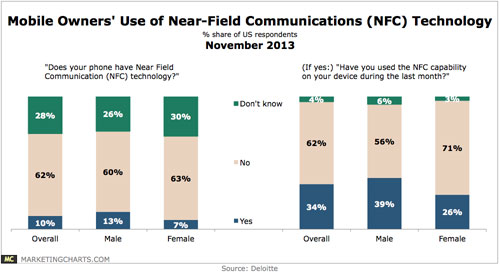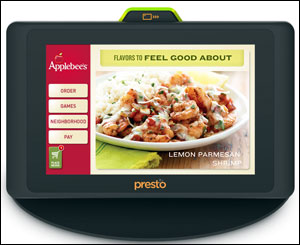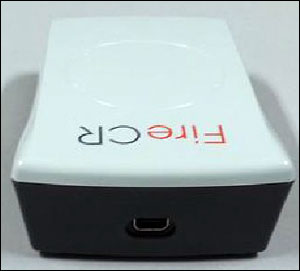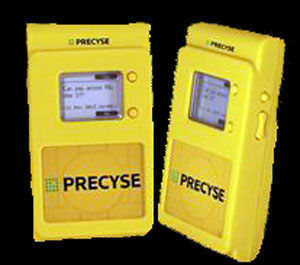Dec 05, 2013The following are news announcements made during the past week by the following organizations: Confidex; Applebee's, E la Carte, Intel; 3DISC; Precyse Technologies; MarketingCharts; IDTronic.
Colorado's E-470 Tollway Adopts Confidex EPC UHF Labels
Confidex, a supplier of specialty RFID tags, has announced that its ISO 18000-6C (EPC Gen 2) passive ultrahigh-frequency (UHF) RFID Windshield RFID labels are being deployed by Colorado's E-470 Public Highway Authority in its all-electronic toll-collection system, known as ExpressToll. The Confidex Windshield label, designed for toll collection, can be attached inside a vehicle windscreen, according to Confidex, and can be read automatically from a distance of several meters, even on a vehicle traveling at high speeds. The label can be customized with surface printing, security markings or special programming. Confidex partnered with RFID IC and reader provider Impinj, and incorporated Impinj's Monza 4E chip into the Windshield Label (see RFID News Roundup: Confidex's RFID Windshield Label Receives Interoperability Certifications from OmniAir Consortium). The E-470 Public Highway Authority operates the E-470 tollway that forms a semi-circular beltway along the eastern perimeter of Denver, and provides access to the Denver International Airport, as well as to various communities in the area. The authority installed the ExpressToll technology in 2009, and the system now processes on average of 3.5 million transactions monthly, according to Confidex. The highway authority chose ISO 18000-6C-compliant technology because it offers a lower cost of operation and fits within national toll interoperability requirements, Confidex explains. In fact, the 6C Toll Operators Committee (6CTOC) is presently working to promote a nationwide standard for the use of passive ISO 18000-6C RFID tags for the purpose of toll collection. Four U.S. tolling agencies that have already adopted the technology formed the 6CTOC in 2011: Georgia's State Road and Tollway Authority (SRTA), the Denver area's E-470 Public Highway Authority, the Utah Department of Transportation (UDOT) and the Washington State Department of Transportation (WSDOT) (see Efforts to Aid Adoption of ISO 18000-6C RFID for Toll Collection Move Forward). Confidex's RFID Windshield labels were qualified by E-470 following intensive nine-month field-testing, Confidex says, and the labels have been customized per the highway authority's specific visual and electrical requirements. The RFID Windshield labels are being used elsewhere, including in Maharashtra, India. For the Maharashtra deployment, Confidex customized its 6C RFID Windshield Labels to provide automatic identification of heavy-goods vehicles and instant access to vehicle data at state border crossings (see RFID News Roundup: India's State of Maharashtra Adopts Confidex RFID Technology for Border Checkpoints).
Applebee's to roll out NFC-enabled tablets at more than 1,000 Restaurants
Chain restaurant operator Applebee's has announced that it will install 100,000 tablets by the end of 2014 that include Near Field Communication (NFC) readers on every table and at multiple positions on restaurant bars at more than 1,000 of its eateries in the United States. The company is deploying E la Carte's Presto, a rugged tablet that features Intel's Atom processor. Guests will be able to use the tablet's NFC functionality to pay for their meals. Patrons will also be able to utilize the tablets to add additional drinks, desserts and other menu items to their meal orders, as well as pay their bills and play games from their seats, according to DineEquity, a company that—through its subsidiaries—franchises and operates restaurants under the Applebee's Neighborhood Grill & Bar and IHOP brands. DineEquity is also considering introducing the tablets to its chain of IHOP restaurants. During the next 18 months, enhanced functionality will be added, such as video streaming, music, additional games, social-media interaction with Applebee's active Facebook community and personal pages, sharing, gift card sales and more. "Let's face it, everyone who has ever been to a restaurant has been frustrated by waiting for their check," said Mike Archer, Applebee's president, in a prepared statement. "Starting out, our goal was to create a way for guests to control when and how they pay their check. What we learned after nearly two years of testing is we can provide much more. The Presto tablet will deliver our guests a robust slate of offerings for not only transactions, but entertainment, social interaction and more, moving forward." A group of MIT engineers founded E la Carte and, during the last five years, has been conducting research and customer trials. "We are thrilled to be selected for a long-term partnership with the industry leader, Applebee's, and we are fully aligned in our vision and commitment to bring the dining experience for restaurant guests into the 21st century," said Rajat Suri, E la Carte's founder and CEO, in the prepared statement. In the Applebee's pilot program, DineEquity reports, the Presto tablets reduced transaction times for guests and provided them with a better overall experience, based on feedback. The Presto tablets will continue to be available in pilot program markets while installation rolls out nationwide.
3DISC Adds RFID to Its Digital Dental X-Ray System
3DISC Imaging, a U.S. company specializing in imaging products for the medical, dental, chiropractic and veterinary markets, has announced a new version of its computed radiography, or cradiography, system for the dental market that features RFID capabilities compliant with the ISO 15693 standard for 13.56 MHz passive RFID tags. The FireCR Dental Reader is used for taking dental x-rays and converting them into digital images, the company reports. Its small size—about that of a shoebox—and features mean that the FireCR Dental Reader can be deployed in individual examination rooms, allowing for faster diagnosis and streamlined patient care, since there is no wait time required to leave the room in order to scan images on a centralized scanner, the company says. The accompanying FireID RFID reader is designed to provide a quick and accurate way to register data relevant to each individual patient, according to 3DISC, and to improve productivity and optimize chairside time with patients. The firm manufactures its imaging plates with RFID tags embedded in them. When a dental technician is ready to perform a patient x-ray, that patient's data is entered into the 3DISC system and the FireID device is used to scan the tagged imaging plate in order to collect its unique ID number. The 3DISC system automatically associates the patient data with the correct imaging plate, prior to an x-ray, explains Joshua Goldman, 3DISC's VP of technical operations. After the technician takes the x-ray, the imaging plate is placed into a tray attached to the FireCR Dental Reader that contains an RFID antenna. The RFID tag within the imaging plate is again scanned, Goldman explains, in order to associate the captured image on the plate (which is displayed on the system) with the correct patient. Once that scan is completed, the system releases that unique ID (via software coding in the 3DISC system) from the patient so the imaging plate can be reused. The RFID functionality enables a dental practice to conduct and review multiple x-rays without mix-ups, Goldman says. "The FireID eliminates accidents, where an image is lined to the wrong patient file," he states. The company has also added support for tablets to review images; 3DISC's new QuantorTab software can be downloaded from an app store for use on tablet computers running Android and iOS operating systems. According to the company, the software features an easy-to-use touch screen interface that provides dentists with immediate access to a patient's dental images.
Precyse Technologies Announces Intrinsically Safe RTLS Products
Precyse Technologies, a manufacturer of real-time location and supply chain visibility solutions based on active RFID technologies, has announced that it has received intrinsically safe certification (Class I, Division 1) for three products in its solution set. This certification is a requirement for systems to operate in many oil, gas, mining and chemical (OGMC) industries, or any industry in hazardous-classified locations (for example, those in which the risk of explosion or combustibility is a concern), the company reports. Precyse Technologies' wireless technology, known as N3, supports wireless sensors, machine-to-machine (M2M) control and real-time location using a single reader infrastructure with a one-mile range. The company's solutions are designed to track the locations and movements of employees or physical assets inside and outside a facility, using patented assisted GPS (A-GPS) technologies. For example, the Precyse system helps emergency responders efficiently identify, locate, sense the status of and communicate with personnel who have not reported to muster points. The solution set, the company adds, includes mobile Smart Agents, wireless network infrastructure, and real-time operations, control room, and health, environment and safety (HES) tools to proactively monitor and manage the workplace, in order to assist emergency response efforts. According to Precyse Technologies, the solution enables users to better coordinate real-time event management, and includes management reporting and analytics that may help improve safety-security compliance and learning. The system is designed to be frequency-agnostic, enabling customers to choose between 433 MHz, 915 MHz, 2.4 GHz or any other custom frequency that maximizes the corporate spectrum use. The products that are now certified as intrinsically safe include the Badge xAgent, Asset xAgent and Micro xBeacon. The lightweight Badge xAgent, an intelligent device used to monitor and communicate with individuals, helps safeguard workers' lives by detecting free-falls (aka a "man-down" scenario), thereby enabling employees to call for help with the single press of a button, and by reporting the worker's location before and during emergency events, the company says. The Badge xAgent provides unique two-way communication between field-level workers and control-room personnel. The Asset xAgent is designed for use in tracking assets. In areas lacking reliable GPS, the small, light, battery-powered Micro xBeacon is easy to install with magnets, zip-ties, metal strapping or similar hardware; each beacon continuously transmits its ID over the air for location reference purposes. The Micro xBeacons are standalone devices that do not require hard-wired network infrastructure connectivity.
MarketingCharts' Analysis Indicates Limited NFC Use in U.S.

According to analysis of new survey data from Deloitte's 2013 Global Mobile Survey, few mobile phone owners in the United States are using Near Field Communication (NFC) capabilities on their phones. The analysis, conducted by MarketingCharts, found that the percentage of mobile phone owners in the United States who said their device has NFC technology has doubled since last year, but that only 1 in 10 respondents indicated that their phone has NFC capabilities, while 62 percent said it does not and 28 percent reported that they do not know. Of those who have the technology, according to MarketingCharts, about one-third said they used the capability in the past month. That, MarketingCharts notes, means that only about 1 in every 30 mobile phone owners claim to have recently used NFC technology. The firm points out that the low NFC usage numbers could be affected by Apple, which has 40 percent of the smartphone market and does not equip its iPhones with NFC technology. MarketingCharts also notes that the Deloitte study demonstrates a fairly significant gender disparity when it comes to both having and using NFC. Male survey respondents were about twice as likely as female respondents (13 percent and 7 percent, respectively) to claim that their mobile phone has NFC technology. Of those for whom this was the case, MarketingCharts reports, 39 percent of males said they had used it during the prior month, compared to 26 percent of females.
IDTronic Updates M3 Orange Mobile PC
IDTronic has announced an update to its M3 Orange mobile PC combined. The new M3 Orange+ features a new operating system (either Microsoft Windows Embedded Handheld 6.5 or Windows Embedded CE 6.0) and ARM's new Cortex-A8 833 MHz processor. It now has 256 megabytes of random-access memory (RAM) and 1 gigabyte of read-only memory (ROM), and is equipped with either a 1D scanner or a 2D imager, HSPA+, Bluetooth, a 3.2 megapixel autofocus camera and a wireless local area network (WLAN) complying with the b/g/n standards. The terminal also now features a wireless wide area network (WWAN) module, a 480-by-640-pixel VGA display, and integrated A-GPS capability. The M3 is available with five different RFID units: ISO 18000-6C UHF; long-range ISO 18000-6C UHF; high-frequency (ISO 14443 A/B and ISO 15693); low-frequency (125 kHz and 134.2 kHz); and LEGIC Prime and Advant.




